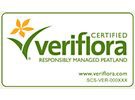This certification insures the client that the peat moss is produced under good condition for the workers and the environment. “Every activity has an impact on the environment, but it’s our purpose to reduce the environmental footprint in peat moss production,” says Geneviève Potvin, Executive Manager at APTHQ. “The association works on peatland restoration after the harvesting period. We have done this together with the Peatland Ecology Research Group for twenty years now and we’ve seen a lot of improvement.”

Restoration of peatland
Despite of the upcoming popularity of other growing media, like coco peat, and of other cultivation methods, like hydroponic cultivation, Geneviève says there is no reduction in the sales of peat moss. “In Québec the sales of peat moss is almost the same for the last 10 years. But we see a change in the use of the peat. A lot of peat is used in combination with other growing media, to create the perfect growing mix.”
 Every grower and every crop is different and therefore there isn’t just one substrate that can be considered the best. Yet there are other issues that can be considered by choosing your growing media. “Coco peat – I prefer to call it coco fibre - is produced in countries where there is not always a strict control on the labour rights. But of course there are also many companies that are doing a good job. But this still brings up the question: do you choose a fairly produced substrate or go for the cheapest product? The peat moss with our VeriFlora® certificate is guaranteed to be produced with respect for the workers and the environment.”
Every grower and every crop is different and therefore there isn’t just one substrate that can be considered the best. Yet there are other issues that can be considered by choosing your growing media. “Coco peat – I prefer to call it coco fibre - is produced in countries where there is not always a strict control on the labour rights. But of course there are also many companies that are doing a good job. But this still brings up the question: do you choose a fairly produced substrate or go for the cheapest product? The peat moss with our VeriFlora® certificate is guaranteed to be produced with respect for the workers and the environment.” 
Quality check on substrates
The benefits of peat moss are that it improves mineral soil structure, it’s less dense and lighter than mineral soil, it helps retain fertilizers and it’s a natural resource free of weeds and contaminants. “In our association only producers of agricultural, horticultural and peat moss that is used for environmental purposes (e.g.: wastewater treatment) are members. In Europe, approximately 50% of the peat is burned to generate energy. That really is a shame, because peat moss is a such an important and beautiful growing media for growing flowers, trees, herbs, fruits and vegetables.”
For more information
APTHQ (Association des Producteurs de Tourbe Horticole du Quebec)
Geneviève Potvin, Executive Manager
P.O. 72
Rivière-du-Loup, Québec G5R 3Y7
T: +1 (0) 418 860-2221
[email protected]
www.horticulturalpeatmoss.com
